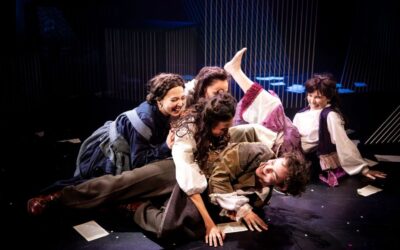Review by George Dixon
Melbourne Opera springs to life with its highly impressive and vocally outstanding presentation of Gaetano Donizetti’s Lucia di Lammermoor.
Even before the overture, The Athenaeum Theatre was a buzz with excitement and high expectations. Not only was it good to be out in Melbourne, but It was also the start of the Opera season. Lucia di Lammermoor is a salient and well-loved Opera based on Sir Walter Scott’s 1819 novel. The Bride of Lammermoor. Its Australian premiere performance was in 1855. While the original story was set in the 1700s, Melbourne Opera’s Lucia di Lammermoor is set 1850s.
Generally, Operas tend to have four key components: Their sets, the costumes, and the music, along with the story. Followed by the dramatics. Lucia di Lammermoor is intense, highlighting the mesmerising music and superb vocals of the major characters and ensemble. The dramatic interpretation is captivating as you journey through the story.
While circumstances have changed, in years past, it was not uncommon for clashing houses to arrange marriages in order to save the families. Lucia di Lammermoor opens the door to the deceit and mental anguish that drives Lucia to madness. Melbourne Opera’s interpretation has, in a sensitive way, allowed the audience to notice the transferable physiological elements of the story.
Melbourne Opera has assembled an outstanding and highly talented cast for this production.

Elena Xanthoudakis as Lucia di Lammermoor is an absolute delight, who brings freshness and authenticity to the character. Her strong coloratura trills completely elated the audience. Likewise, her staging and presence were commanding. The transition from a headstrong, in-love person to one of coerced compliance, building to the pinnacle “mad scene”, is outstanding, holding the audience’s attention as she moves around wielding a blood-stained dagger, threatening the lives of those around her. The vocal and facial expressions underscored her dilemma, being true to her word and feelings towards Edgardo and her love and loyalty to her brother Enrico.
Simon Meadows, as Enrico (Lucia’s Brother), Is presented as an imposing brother who, at best, is a self-interest bully, trying to save his skin by manipulating his sister into an arranged marriage with his foe Arturo. Meadows’s physicality is intimidating, being a tall bald person with a loud Baritone voice. His in-your-face presence punctuates the intensity of his situation and desperation to intimidate Lucia by any means into submission. The physiological impact of his presence, mannerisms, facial expressions, and tone of voice all match that of a typical bully. While some may find this portrayal somewhat overpowering and, at times, vocally strong, I felt it added to the character’s dimension and intensity.
Henny Choo as Edgardo is well cast. His flamboyant nature contrasts that of Enrico. His smaller stature and strong tenor voice provide a balance between the other two main characters. One cannot help believing that he is on the outer of the family yet finds himself pleading the case for his beloved Lucia. Choo cuts an emotional grief-stricken suitor who remains true to his word and feeling. His final scene at the graveyard is both moving and impressive.
Robert Macfarlane, as Arturo, is exquisite in developing the character’s brief yet commanding presence; a realistic, off-the-cuff, “let’s get this over with” attitude is quite dismissive while being conscious of the situation he is stepping into, yet unprepared for the dreadful outcome that awaits him. A nice touch that highlights the class difference is Arturo’s displeasure with the poor quality of the wine.
Eddie Muliaumaseali’I, as the chaplain, Raimondo, is perfectly cast. His awesome stage presence and strong Bass voice provide a tower of strength and authority. Muliaumaseali’I’s mannerisms and timing are reflective of a considered, learned cleric. His booming, powerful voice enhances and lifts the choirs to another level.

Suzanne Chaundy, the Director, has excelled with this production; working with a small stage (in terms of an Opera), the Athenaeum is not without its challenges. Hats off to all the cast and technical team. Every inch of the stage area was utilised without overcrowding. Each scene flowed naturally, resetting the time period allowed for simplistic yet effective costuming. The dramatic direction was flawless, which added to the intensity of the Opera.
Dale Ferguson Set Design was simplistic and effective based on the premise that less is more. While the set was dark, it provided an effective backdrop to highlight the costumes.
Harriet Oxley Costume Design is outstanding with the costumes of the 1850s, generally, browns and greys with the occasional red with scattered tartan dresses to remind us the setting is in Scotland. The wedding gown was spectacularly white, with a veil; the blooded gown is also a standout, punctuating Lucia’s madness and horror.
Peter Amesbury Lighting design has developed a realistic balance of dim lighting for the inside effects and night darkness, as in the outside courtyard and the cemetery, while highlighting the cast and performers. This subtle, subdued balance brings a realistic atmosphere to each scene, which does not distract from the performance.
Raymond Lawrence, Conductor, provides a musical masterclass, from the first note to the last; the use and selection of the orchestra and instruments present a full, rich sound, the interaction and musical exchange between soloists and orchestra was at times seamless, all of which richly enhanced the experience. It was pure joy to experience the synergy.
Melbourne Opera has presented an entertaining and delightful experience. Clearly, the full house audience and cast were absolutely delighted with the outcome. The concluding applauses continued through five curtain calls.
Photo credit: Robin Halls





